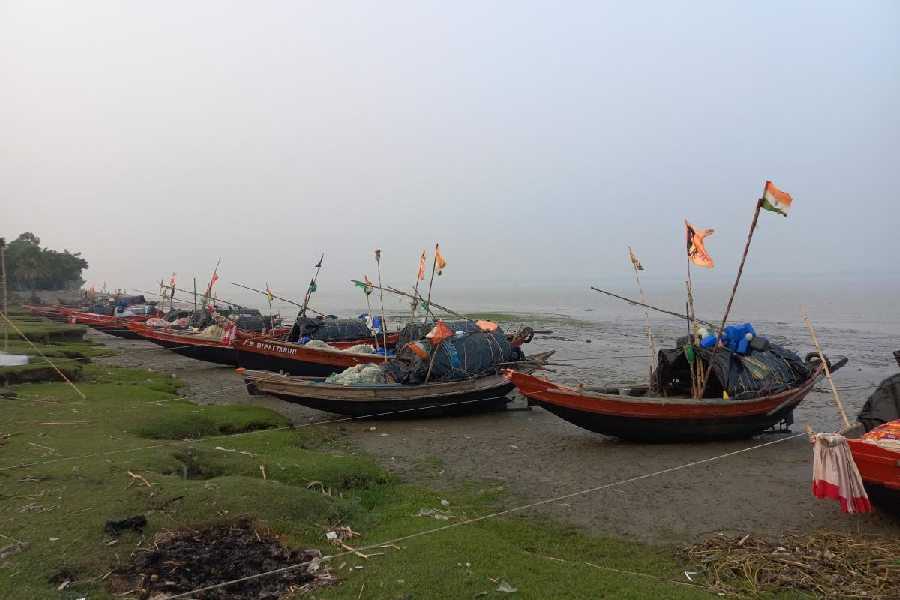We have been here in Jhikurkhali for generations,” says Sheikh Asgar Ali, 43. He continues, “But now, we have had to quit the river.”
It has been two years since Ali stopped taking his boat into the river. His catch has reduced to half in the last decade. “You need to hire at least five people for the job. But I can’t pay them,” he adds.
Jhikurkhali is one of the many villages along the banks of the Hooghly river near Bengal’s Haldia town. It is seven kilometres from Durgachak, which is the centre of Haldia township, surrounded by production units of Haldia Petrochemicals, Tata Chemicals, Marcus Oils and other factories of the petrochemical chain.
These villages, more than 20 of them, were traditionally home to the fishing community. They caught fish near the riverbanks during low tide and sailed into the river at high tide. Now, most of them are either struggling or trying to find other sources of income. There has never been an official count of people involved in fishing here, so the loss of livelihood remains invisible.
Many reasons are ascribed to the low catch. But most blame it on the industries in the belt. In 2018, the Central Pollution Control Board (CPCB) ordered Tata Chemicals to shut down its Haldia plant for alleged non-compliance of the prescribed norm of liquid effluent discharge. In 2010, the environment ministry marked Haldia a “critically polluted area” and banned expansion of industries. The ban was lifted in 2013.
State pollution control board officials say pollution data for the last three years shows improvement but people living in the adjoining areas complain of polluted air, breathing problems and skin patches. In the last few years, there have been constant complaints of periodical dark, stinky water and polluted fish. This has practically stopped fishing activity near the banks.
“Every time we catch fish near the bank, the fish give off a petrol-like stink when cooking. Some of us have had to return money to customers, some of us have been assaulted,” says Sudarshan Bhuiyan, 59, who lives in a shanty in Durgachak. He has given up fishing to do manual labour on short contracts.
This is now a known phenomenon in the Haldia market. A 2022 study done by Moumita Maity, who is assistant professor in the department of applied science at the Haldia Institute of Technology, found water toxicity impacting human as well as fish health of the area. In a study published in the environment science and biotechnology journal EM International, she observes: “Site D (near Patikhali ferry ghat) is a canal which flows beside the premises of many industries like Exide, Indian Oil Corporation Limited, Hooghly Met Coke and Power Company, Bharat Petroleum Corporation Limited, etc. The respondent reports that in the fish caught for consumption from this canal, the flesh smells very badly which is evidence of high rate of pollution. Not only that, fish kill is also a common phenomenon in site D.” Fish kill is the term for localised fish deaths.
Lead is one of the major pollutants apart from other heavy metals such as cadmium and chromium. Another study on heavy metals in fish muscles by marine scientist Abhijit Mitra published in the peer-reviewed, scientific journal Environmental Monitoring and Assessment takes note of the high levels of zinc and copper in shrimp muscles in Nayachar island, which faces Haldia and is in the Hooghly estuary.
All of these are commonly known wastes of the petrochemical industry.
Maity points out that the impact along the riverbanks is visible and obvious but given the upstream and downstream mixing of water, there is a definite possibility of impact deep into the river in the long run. Mitra’s study has found metal deposits in dead fish in different parts of the river. He says there is no notification from the CPCB or other authorities regarding permissible levels of heavy metal deposits in fish muscles. “This makes it difficult for legal action on the point of source and is a major hurdle in achieving sustainability of food, health and economic security of the region,” he says.
“I can’t say for sure which factory is releasing such pollutants but once released, there is a foul smell,” says Bhuiyan, who lives close to the riverbank. Another fisherman, Shankar Das, 47, who lives near Durgachak, says, “When we wash ourselves in the river, our bodies start to itch.”
Many fishermen have started working as construction workers and in brick kilns. “It is fishing season and you can see boats parked on land. This was unimaginable some years ago,” says Rabidranath Patra, who owns a small fishing boat and is an activist associated with the Dakshinbanga Matsyajibi Forum (DMF), an organisation working with fishermen in the state. He encourages fishermen to get themselves registered.
In December, fishermen and members of the DMF submitted a memorandum to the West Bengal Pollution Control Board chairman demanding an investigation into the toxic fish in the waters adjoining Haldia. They are yet to get a response.











